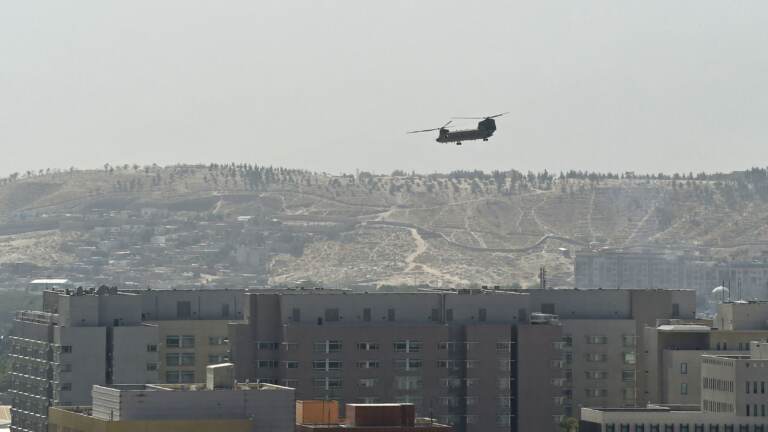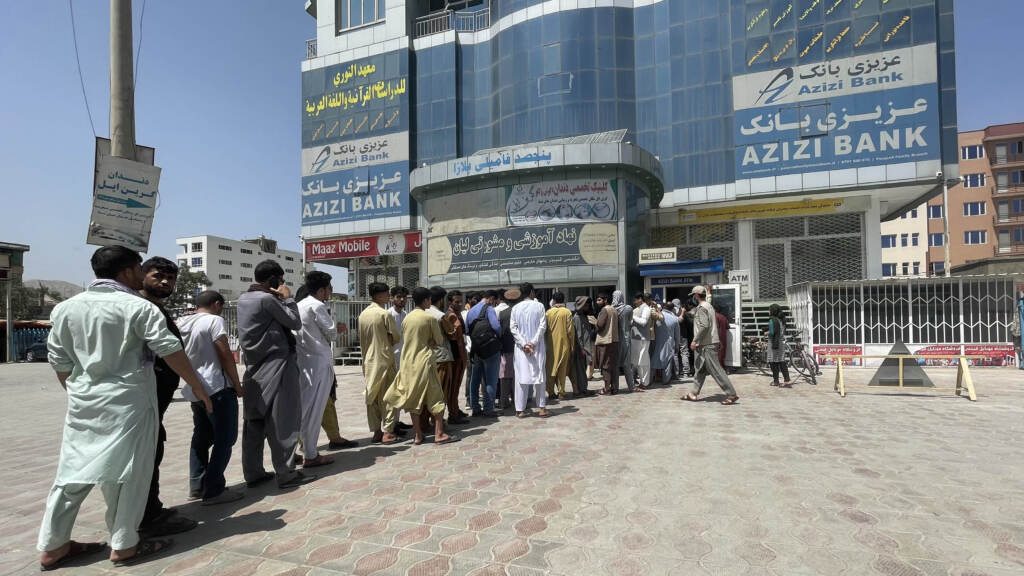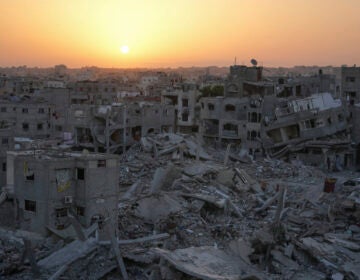Afghanistan falls to the Taliban again as the U.S.-backed government collapses

A U.S. military helicopter is pictured flying above the U.S. Embassy in Kabul on Sunday. The Taliban swept into Kabul, facing little resistance. (Wakil Kohsar/AFP via Getty Images)
Twenty years after being removed from power in a U.S.-led invasion, Taliban militiamen swept to into Afghanistan’s capital, Kabul, on Sunday, facing little resistance from Afghan government forces.
Within hours, Afghanistan’s Washington-backed president had left the country and the flag at the U.S. Embassy had been lowered amid a hasty evacuation of diplomatic personnel.
Ashraf Ghani, Afghanistan’s president, said on Facebook that his was “a hard choice,” but that he decided to leave to prevent bloodshed. He signed off his post with “Long Live Afghanistan.” The Taliban released a statement saying they had entered the capital of 6 million people and were working to restore law and order.
On Saturday, the militia’s fighters took the last remaining government stronghold of Mazar-e-Sharif, followed quickly on Sunday by the city of Jalalabad, which lies just east of Kabul on a major road artery.
By Sunday, Kabul was a scene eerily reminiscent of the fall of Saigon in 1975 in the wake of the Vietnam War, as helicopters circled the U.S. embassy as its diplomatic personnel were under evacuation orders. The comparison to Vietnam was one that U.S. Secretary of State Antony Blinken was keen to dismiss: “This is not Saigon. We went to Afghanistan 20 years ago with one mission, and that mission was to deal with the folks who attacked us on 9/11 and we succeeded in that mission,” he told CNN’s State of the Union.
In an alert on Sunday, the U.S. embassy cautioned of reports that Kabul’s airport was “taking fire” and that “we are instructing U.S. citizens to shelter in place.” A U.S. military official told NPR the airport was closed to commercial aircraft as military evacuations continue.
Earlier, the White House had ordered about 5,000 troops to be sent to Afghanistan to provide security and assist in evacuations of U.S. personnel. The Pentagon confirmed on Sunday another 1,000 would head there as well.
An ignoble end to America’s longest war
The day’s events were a dramatic coda to America’s longest war, prompted by the Taliban’s refusal to hand over Osama bin Laden in the immediate aftermath of the Sept. 11, 2001, terrorist attacks. Within weeks of the attacks on New York and Washington, D.C., U.S.-led forces invaded the country, toppling the Taliban by year’s end.
But that involvement stretched from months into years. Since then, more than 2,400 U.S. service members, some 3,800 American contractors, more than 1,100 other allied service members, and an estimated 66,000 Afghan national military and police have lost their lives due to the conflict, along with more than 47,000 civilians, according to Brown University’s Costs of War Project.
Ultimately, the U.S. price tag for two decades in Afghanistan runs as high as $2.26 trillion, including the cost of rebuilding the Afghan government and training its military.
Blinken on Sunday sounded a note of bitterness over the rapid collapse of the 300,000-strong U.S.-trained Afghan security forces, which “proved incapable of defending the country” — an eventuality that “did happen more rapidly than we anticipated,” he acknowledged.
That sentiment was echoed by the former NATO supreme allied commander, Ret. Adm. James Stavridis: “You can buy all the equipment in the world, but you can’t purchase leadership or political will or in particular, battlefield will,” Stavridis told NPR’s Weekend Edition. “And therefore, we see this ghosting of the Afghan army. It’s quite heartbreaking.”
Meanwhile, on the ground in Kabul, chaos and fear were the order of the day as the Taliban — with their well-deserved reputation for repression and brutality, particularly toward women and ethnic and religious minorities — began taking charge.

‘Thieves, robbers, all the looters are out’
Many Afghans waited in long lines at banks to withdraw money, concerned about what might happen to their savings under a new regime.
One resident, who NPR is not identifying to protect from possible reprisals, described chaos in the capital.
“Right now, the thieves, robbers, all the looters are out and trying to loot cars — whichever are traveling right now,” the woman said. “[There are] gunshots everywhere.”
She added: “In [our neighborhood] we have this guard with a gun and he also just shot at someone because people are trying to loot houses and whomever is passing by the road.”
Still others in the capital appeared to welcome their new rulers.
Matthieu Aikins, a freelance journalist in Kabul, tweeted late Sunday that he’d just returned from the western part of the capital, “where this evening there were extraordinary scenes of Taliban fighters leaving the capital in captured Humvees and police trucks, brandishing M16s, cheered on by crowds of bystanders, chased by packs of children.”
In a series of tweets, former Afghan President Hamid Karzai says he, along with Abdullah Abdullah, who represented the Afghan government in earlier negotiations with the Taliban, and head of the Hezb-i-Islami party and former warlord Gulbuddin Hekmatyar, were forming a “coordinating council” to “prevent chaos and reduce the suffering of the people and to better manage the affairs related to peace.”
But with the Taliban holding virtually all the cards, it wasn’t clear what, if anything, such a council or an interim government could do.
The White House and a former Trump official point fingers
As the final offensive against the capital seemed all but certain on Saturday, President Biden issued a statement that sought to distance his administration from the unfolding outcome, emphasizing that the peace agreement that promised the withdrawal of all U.S. forces from Afghanistan had been hammered out under former President Donald Trump.
“I inherited a deal cut by my predecessor,” Biden said. It left the Taliban “in the strongest position militarily since 2001 and imposed a May 1, 2021 deadline on U.S. forces.”
“Shortly before he left office, he also drew U.S. forces down to a bare minimum of 2,500,” Biden said.
Speaking on Fox News Sunday, former Secretary of State Mike Pompeo, who was instrumental in negotiating the Trump administration’s peace deal with the Taliban, blamed the Biden White House for the debacle.
“It looks like the Biden administration has just failed in its execution of its own plan,” Pompeo said.
As recently as Friday, State Department spokesperson Ned Price told NPR that the White House was still counting on Afghan security forces to stand up and fight against the Taliban.
“What we know, what we’re confident in is that the Afghan National Security Forces do have a sizeable force. What we need to see now is that put to use in an effective way,” he said.
The Taliban victory and the evacuation of the U.S. embassy cut short a special immigrant visa program for Afghan interpreters and others who had assisted the American effort in the country and might now face reprisals from the Taliban.
Price said on Friday that the U.S. had been “dramatically scaling up that operation.”
“We have been able to bring to their new lives here in the United States 1,200 Afghans to date,” he told NPR.
Even so, he said: “We realize that is insufficient given the scale of the number of Afghans who have put themselves, potentially put their families, at risk to help us.”
9(MDAzMzI1ODY3MDEyMzkzOTE3NjIxNDg3MQ001))




